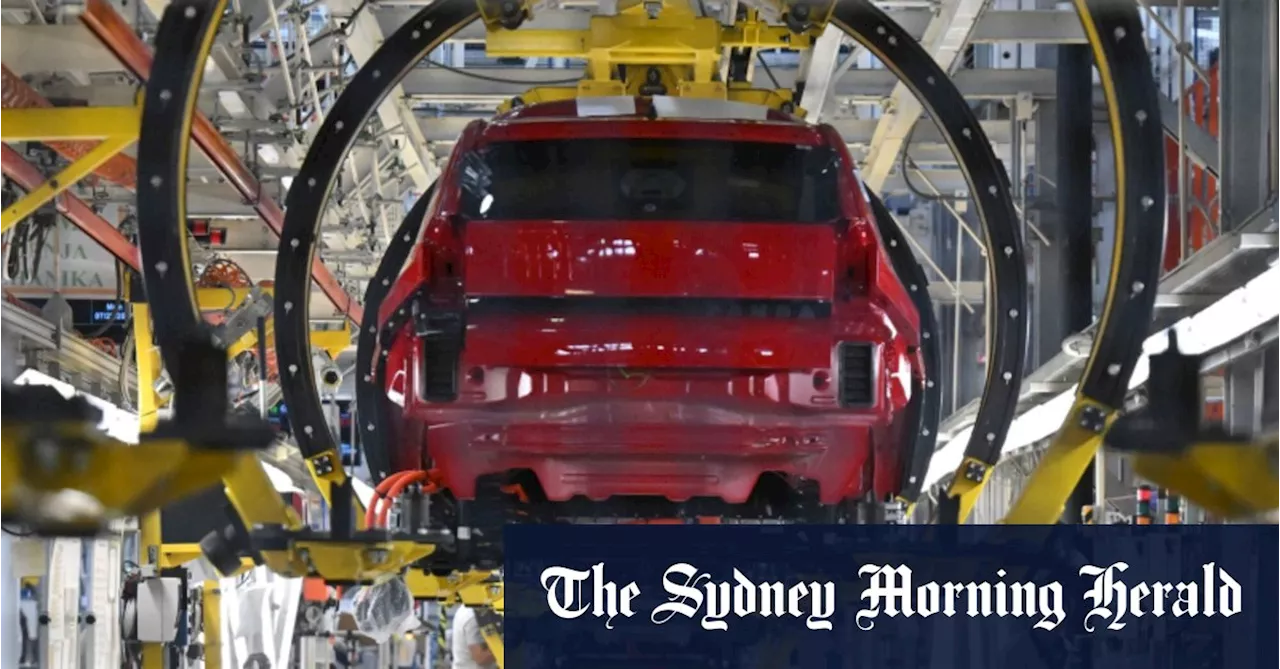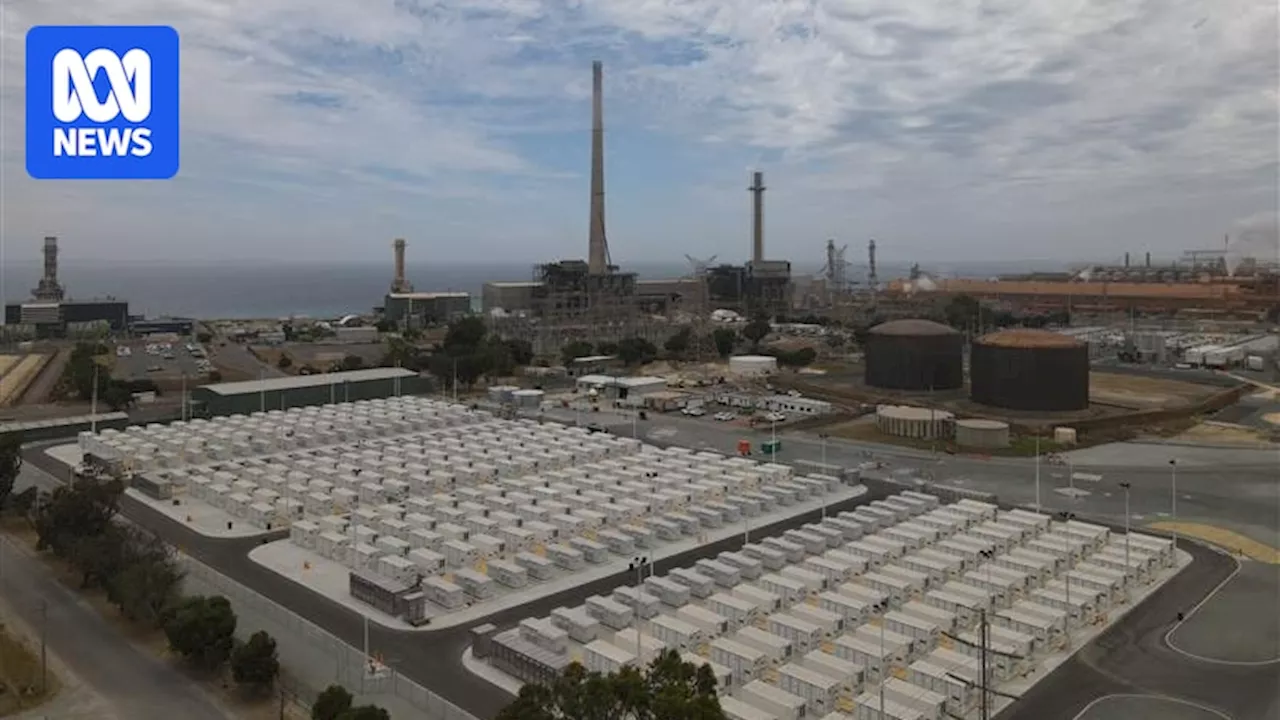Western Australia is embarking on an ambitious bet on big batteries to address the challenges of integrating renewable energy into its isolated grid. While proponents highlight the potential of batteries to store excess solar power and smooth out demand fluctuations, critics warn that they are not a silver bullet and the reliance on fossil fuel power stations for baseload power persists.
An old coal-fired power plant is being deconstructed alongside a brand new big battery in Kwinana, Western Australia . In the world's biggest isolated grid in Western Australia , a huge bet is being placed on big batteries. Large-scale batteries are sometimes powering up to half the demand in Perth, a city of 2 million people. There are plans to add significantly to the battery fleet, but sceptics warn it's not a panacea for the transition.
At a site in the industrial suburb of Kwinana, about an hour south of Perth, coal was once stockpiled high. The black fuel would be loaded on to a conveyor belt and transported just a few hundred meters away to a giant plant that sat on the edge of the turquoise Indian Ocean. From here, it would be pulverised, fed into a huge furnace and used to generate much of the power that kept Western Australia's capital running. Big batteries are periodically powering up to half Perth's demand for electricity. Whereas once there was the din of trains, trucks and heavy machinery, now there is little but a low, monotone hum. And whereas once there was dirt, dust and the steady emission of pollution, nowadays there is a near-sterilised cleanliness and whiteness all around. The former coal yard is today the site of batteries that are big enough to power half a million homes for several hours. 'One of the challenges as everyone knows about renewables is the sun doesn't always shine and the wind doesn't always blow,' says David Fyfe, the boss of State-owned WA power utility Synergy. A monument to storage In Kwinana, two sit side by side. With a size of 100 megawatts and a capacity to run for two hours, the battery was for a time one of the biggest in Australia. But last month it was eclipsed by the commissioning of a second, sister battery, which can run at 200MW for four hours. Further down the road near Collie — the traditional home of coal mining and coal-fired power production in WA — there are batteries that are vastly bigger still. Late last year, French renewable energy player Neoen cut the ribbon at a gargantuan 560MW/2240MWh installation just outside the town. By this October, Synergy is scheduled to bring online a similarly massive facility just around the corner. Gavin Mooney from smart energy platform Kaluza says the world's eyes are on WA's big battery gambit. Gavin Mooney, the head of smart energy platform Kaluza, says what's happening in WA is remarkable.'A couple of years ago, there wasn't a single battery there. By the end of this year, the state's going to have more than 1,500 megawatts of batteries installed.'So relative to the average demand of 2,800, this is a really big chunk.' WA's gambit on big batteries is aimed at solving a raft of the problems posed by the shift towards renewable energy — and away from fossil fuels. Arguably, however, it's centred on something little-known outside of the energy industry — a phenomenon called load shifting. The term refers to shifting demand for electricity — load — to those times of the day when supply might be more abundant. One in every four WA homes has solar panels.'Western Australia now has over 40 per cent of households with solar panels on the roof,' Mr Fyfe notes. 'In the middle of the day, a 23-degree day, maybe on a Sunday, for example, we end up in a situation where there's more energy coming into the system than there are people to use it.'He says rooftop solar is increasingly defining Australia's electricity supply and the design of the system needs to reflect this.'We have all this excess rooftop solar, and it's being exported to the grid. And it needs to be used somewhere.'By charging up in the middle of the day, the batteries can start to soak up some of that rooftop solar and actually increase demand in the middle of the day. 'They can then start discharging in the evening when we have a peak in demand, people get home from work, they turn on the air conditioning, they turn on the oven, and so on.'(Mr Fyfe says using batteries in this way avoids placing the burden on households to shift their own demand to the middle of the day. He notes many consumers can — and do — change their behaviour to capitalise on cheap solar power when it's available.'You build more generation or you change behaviour.'You know, people aren't home in the middle of the day.'For all the optimism about batteries and their benefits to the system, others aren't so sure. He says batteries are 'very useful', particularly in shifting energy around on a day-to-day basis, but they are not a panacea because they don't generate electricity themselves. Andy Wearmouth says batteries are being wrongly held up as a 'silver bullet' for the energy transition.'All they can do is store energy that they've taken from somewhere. The vision is that that will be taken from rooftop solar or wind and stored. 'But the problem is the coal-fired power station can bang away for days and weeks on end producing its energy at its name-plate ratin
Renewable Energy Batteries Western Australia Electricity Grid Load Shifting Solar Power Fossil Fuels
Australia Latest News, Australia Headlines
Similar News:You can also read news stories similar to this one that we have collected from other news sources.
 Celebrity Shakespeare: A Risky Gamble?Sigourney Weaver's recent performances as Portia in The Merchant of Venice and Prospero in The Tempest have received harsh criticism, raising questions about the trend of casting film stars in Shakespearean productions. While producers are drawn to the star power and guaranteed ticket sales, the quality of these performances often falls short, potentially harming the future of theatre.
Celebrity Shakespeare: A Risky Gamble?Sigourney Weaver's recent performances as Portia in The Merchant of Venice and Prospero in The Tempest have received harsh criticism, raising questions about the trend of casting film stars in Shakespearean productions. While producers are drawn to the star power and guaranteed ticket sales, the quality of these performances often falls short, potentially harming the future of theatre.
Read more »
 India vs Australia: Spin Dominance and Rishabh Pant's GambleThe article discusses the strategic bowling choices made by Australia during a cricket match against India. The focus is on the use of spin bowlers, particularly Ravindra Jadeja and Nathan Lyon, and Rishabh Pant's aggressive shot against Head.
India vs Australia: Spin Dominance and Rishabh Pant's GambleThe article discusses the strategic bowling choices made by Australia during a cricket match against India. The focus is on the use of spin bowlers, particularly Ravindra Jadeja and Nathan Lyon, and Rishabh Pant's aggressive shot against Head.
Read more »
 Strikers Gamble on Short's Fitness for Renegades ClashThe Adelaide Strikers are hoping captain Matt Short can recover in time to face the Melbourne Renegades. The Strikers are on a three-match losing streak and need a win to stay competitive.
Strikers Gamble on Short's Fitness for Renegades ClashThe Adelaide Strikers are hoping captain Matt Short can recover in time to face the Melbourne Renegades. The Strikers are on a three-match losing streak and need a win to stay competitive.
Read more »
 Jaguar's Electric Gamble Signals Global Automotive ShakeupJaguar's bold new direction towards high-end electric vehicles, symbolized by the enigmatic Type 00 concept, reflects a broader shift in the global automotive industry. Faced with increasing competition and technological advancements, major automakers are making radical moves, from executive departures to plant closures and strategic pivots.
Jaguar's Electric Gamble Signals Global Automotive ShakeupJaguar's bold new direction towards high-end electric vehicles, symbolized by the enigmatic Type 00 concept, reflects a broader shift in the global automotive industry. Faced with increasing competition and technological advancements, major automakers are making radical moves, from executive departures to plant closures and strategic pivots.
Read more »
 Neymar's MLS Move: A Dream Reunion or a Risky Gamble?Could Neymar's rumored move to Inter Miami reunite the iconic 'MSN' trio? The article explores the potential benefits and drawbacks of this hypothetical transfer, considering Neymar's recent injury struggles and the success of other aging stars in MLS.
Neymar's MLS Move: A Dream Reunion or a Risky Gamble?Could Neymar's rumored move to Inter Miami reunite the iconic 'MSN' trio? The article explores the potential benefits and drawbacks of this hypothetical transfer, considering Neymar's recent injury struggles and the success of other aging stars in MLS.
Read more »
 Star Entertainment's Gamble for SurvivalStar Entertainment, Australia's major casino operator, is facing a precarious financial situation and may require a stroke of luck to avoid administration. The company is burning through cash rapidly, with dwindling reserves and demanding loan conditions from creditors.
Star Entertainment's Gamble for SurvivalStar Entertainment, Australia's major casino operator, is facing a precarious financial situation and may require a stroke of luck to avoid administration. The company is burning through cash rapidly, with dwindling reserves and demanding loan conditions from creditors.
Read more »
